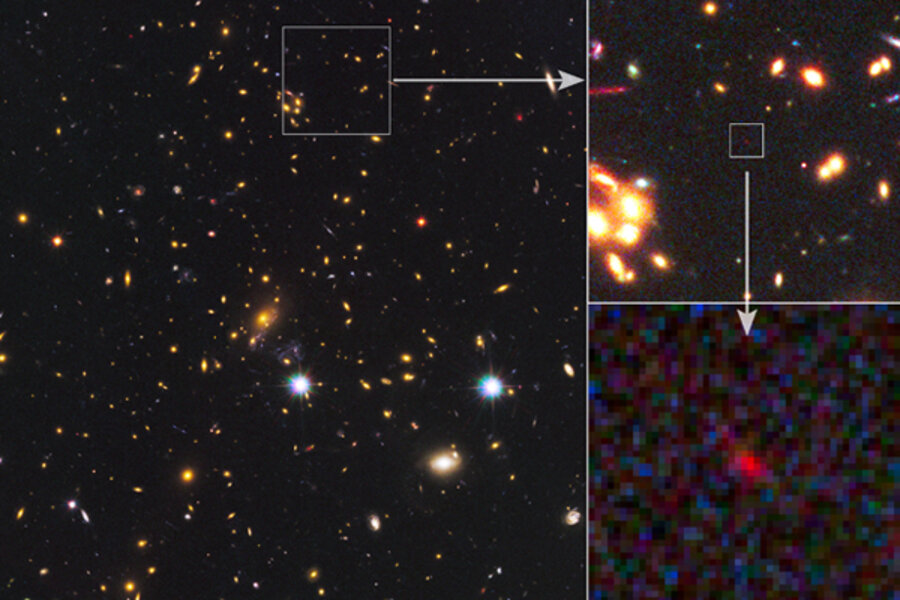Distant galaxy helped tidy up early universe, scientists say
Loading...
A hunt for galaxies that brought the toddler universe out of its dark ages has bagged what may be the most distant specimen yet discovered, a galaxy seen as it was more than 13 billion years ago when it was just 200 million years old.
The galaxy, which was found using data from the Hubble and Spitzer Space Telescopes, is seen when the universe was only 500 million years old. A munchkin by today's standards, the galaxy’s mass was 200 million times the mass of the sun, compared with 700 billion solar masses for the Milky Way or 10 billion solar masses for the Milky Way's smaller companion, the Large Magellanic Cloud.
But the newly discovered galaxy's age – and the preponderance of hot, massive stars it hosted – place it among a category of objects that researchers say helped convert a fog of neutral hydrogen gas permeating the ancient universe into the transparent cosmos we see today.
The process, known as re-ionization, is thought to have started around 400 million years after the Big Bang, a sudden release of an enormous amount of energy that cosmologists have tagged as the birth of the universe.
Over the next 600 million years, stars and galaxies formed and the universe continued to expand. Radiation from the first generations of stars – and particularly from emissions stemming from the actions of super-massive black holes at the hearts of the rising number of growing galaxies – ionized the intergalactic hydrogen, in effect lifting the fog.
Relics of this period, 13-billion-year-old stars, populate the halo of the Milky Way, notes Wei Zheng, an astronomer at the Johns Hopkins University in Baltimore and the lead author of a formal report of the discovery, which is being published in Thursday’s issue of the journal Nature.
In a sense, the galaxy he and his colleagues have uncovered opens a window on the infant stages of our own galaxy.
"This is just like being an archaeologist" hunting for evidence of early civilizations, Dr. Zheng says. "You know it must be there. It's exciting to see the real pieces."
The ability to study these galaxies and their role in the universe's evolution is expected to take a big leap forward when NASA launches the James Webb Space Telescope, currently slated for lift-off sometime in 2018.
The team's report is not the first claiming evidence for galaxies during this crucial time in the evolution of the universe. Over the past eight years, a few groups using ground- and space-based telescopes have reported detections of infant galaxies at comparable distances – some 13 billion to 13.3 billion light-years away.
But uncertainties in the analysis of these previous detections are large, researchers say, owing to the faintness of the objects and to the limited amount of data researchers could gather on telltale signs in the galaxies' light that help estimate distance.
In overcoming the faintness issue, Zheng and his colleagues had a strong ally in Albert Einstein. Among the well-validated predictions of Einstein's theory of general relativity: Intense gravity can bend light. And it can magnify light in a process known as gravitational lensing.
The galaxy Zheng's team observed lay behind a galaxy cluster tipping the cosmic scales at 2 million billion solar masses – making it one of the most powerful gravitational lenses known. The lensing effect brightened the early galaxy's light substantially, making it possible to gather enough data to estimate the galaxy's size – tiny enough that it could get lost in the disk of the Milky Way – as well as its mass and the relative abundance of younger and older stars.
The data were gathered by the Hubble Space Telescope, as part of a long-term project to use galaxy clusters and gravitational lensing to test theories about the nature of dark energy. In addition, the team used the Spitzer Space Telescope. Hubble can capture images at wavelengths ranging from ultraviolet at the high end to near-infrared at the low end. Spitzer can detect objects via light well into the infrared range.
The ability to detect light at longer, infrared wavelengths is critical for detecting objects at such distances. The universe is expanding at an increasing pace, and astronomers long ago established that the farther away an object is, the faster it is receding. This phenomenon in effect stretches light from a distant object to longer, redder wavelengths, a feature astronomers have dubbed red shift.
In its immediate neighborhood, the newly discovered galaxy would shine most brightly in the ultraviolet. By the time that light reached Earth, the universe's expansion has stretched the light into infrared or near-infrared wavelengths.
Thus, the combined capabilities of the two telescopes, plus the brightening from gravitational lensing, allowed the team to estimate the galaxy's distance with the highest precision yet achieved for such an observation, Zheng says.
The team also was able to infer something about the galaxy's age and population of stars in the galaxy from the measurements Spitzer made, Zheng says. The proportion of older to younger stars teased from the galaxy's bulk light emissions point to a galaxy no older than about 200 million years.
This was a fecund period for star formation, other researchers have noted. Although solid observations of baby galaxies such as the one Zheng's team uncovered are clearly rare, more-readily spotted galaxies that fall within the next several hundred million years of cosmic evolution boosted their star formation rates 10-fold over that period, according to a paper published last year in Nature by a team led by University of California at Santa Cruz astronomer Rychard Bouwens.





